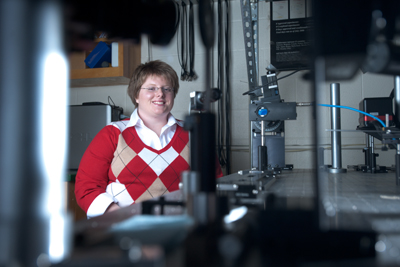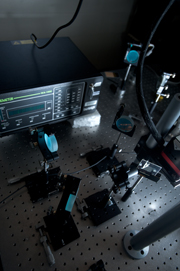Gretchen Phelps
Ph.D. Student
by Kathryn Wallingford
photos by Shaun Ring
Gretchen Phelps refers to her research as “SMOKE ‘n Mirrors.” While it sounds like a magic act, if you did not see Phelps and the optics set-up of her latest experiment, you might just think her research was just that.
Don’t let the title fool you. Phelps is a fourth year Ph.D. student in University of Kentucky’s Department of Physics and Astronomy and SMOKE actually stands for ‘Surface Magneto-Optic Kerr Effect,’ a technique utilized by condensed matter physicists for the reflection of polarized light by a material that is subject to a magnetic field.
Under the mentorship of UK’s Physics professor, Dr. Wolfgang Korsch, Phelps has the potential to make exciting contributions to one of the fundamental questions driving nuclear physicists today, “Does a neutron have a nonzero permanent electric dipole moment (EDM)?"
Thus far, physicists have used what is known in physics as the ‘Standard Model’ to make estimates on the n-EDM. Phelps said, “The Standard Model (SM) predicts that the neutron EDM is on the order of 10-31 e•cm, a measurement of the charge times the distance of separation.” Proposed extensions beyond the SM predict a larger n-EDM. These extensions are then tested via research projects with a greater sensitivity for measuring the n-EDM.
“This study we are working on is actually part of a larger collaboration with Oak Ridge National Lab (ORNL). The ongoing experiment at ORNL proposes a sensitivity of 10-28 e•cm, thus reducing the present limit by two orders of magnitude,” said Phelps.
Understanding the complexity of her work, Phelps began our interview with a short lesson in physics and the significance of an “EDM.” “Let’s take a step back for a minute,” Phelps began reassuringly.
The most basic unit of matter, the atom, hosts within its nuclei tiny particles known as protons and neutrons. ‘Quarks’ make up the protons and neutrons and they in turn are held together by what is known as ‘strong interactions.’ “On average these quark charges have no charge separation along the spin axis of the neutron. However, if a symmetry known as time-reversal (T) is violated, a small permanent separation of the charges is possible, resulting in more positive charge at one end of the spin vector than at the other,” Phelps said. “If the neutron were the size of the earth,” Phelps continued, “then the distance of charge separation ORNL proposes to measure is the diameter less than a human hair.”
Although to some it seems like such a miniscule and almost unobservable measurement, Phelps has always recognized the importance of precision and mathematical equations.

A native of Rockcastle County, Ky., Phelps grew up with a “thing” for numbers. Phelps added, “I also had this incredible math teacher who made me appreciate math even more.” However, it was not until her senior year of high school, that Phelps was introduced to physics. What began as a fascination with numbers soon became a love for understanding the conservation of energy and momentum. Phelps only wishes she had found the basic fundamentals of physics before her senior year of high school. “I saw the math aspect and thought it was really cool that you can apply numbers to physics. Equations actually mean something.”
After high school, Phelps traveled and hour and half down the road to Kentucky’s University of the Cumberlands and had no trouble determining her major, or double major- math and physics. Phelps even found the time to add a French minor into her academic load. “It was a busy time,” she remembers.
A Cumberland physics professor tipped her off on the research conducted at UK and felt research was an appropriate path. “It is a very exciting time for physics right now and determining if there is something beyond the Standard Model.”
To contribute to this experiment at large and revise the SM with greater sensitivity requires precise measurements and the SMOKE technique. For the past two years, Phelps has been setting up the SMOKE experiment which requires the alignment of laser beams to a small 0.5” x 0.5” ‘supermirror’ sample.

By measuring the changes in polarization of light reflected off of this supermirror, Phelps will be able to detect magnetic properties of the sample. “The idea is that the supermirror we use in our SMOKE research is just a piece of the n-EDM experiment at Oak Ridge,” she explained. But instead of the small supermirror Phelps is using in her SMOKE research, Oak Ridge will rely on much larger “neutron guides” as their sample.
“Our job is to study the properties of the mirror and apply it to the larger project,” said Phelps.
“Ultimately we have three goals, we will determine how uniform the magnetization is across the mirror, if it is sufficient to only magnetize a portion of the mirror, and how often does the mirror need to be magnetized.
In the final experiment we use low energy nuclear precision experiments to test high energy physics. If we find something we are able to measure, then we know that the Standard Model does not completely describe everything, that there is something else out there.”
